Media | Articles
6 cars that flopped outside their home markets
2023 marks 50 years since the lovely Volvo P1800 ended production. Oddly enough, two other cars in this list exited stage left in 1973: The Sunbeam Minx and the Opel GT. This article originally ran in 2019 but, given those coincidences, we couldn’t resist sharing it again. —Ed.
The iconic WWII Willys Jeep and its later English rival, the Land Rover, have been sold around the world for almost 80 years. They make sense pretty much everywhere.
However, some cars just don’t translate to other countries, even if they were hugely successful where they were born. These include the tiny 1948–1990 two-cylinder Citroën 2CV and the 1959–2000 British Motor Corporation Mini. Based on their domestic reputations, each sold more than five million copies in 40 years. Overseas, they appeal to contrarians, who don’t care that they are small and slow.
Cross-cultural efforts have produced an endless list of unsuccessful transplants. Whether the brand name is changed or not, they just don’t fit, and some of the more bizarre attempts have been quite recent. Even if the cars were mechanically sound, a lack of parts and weak service support outside their domestic markets often proved insurmountable. Here are 6 such cases where cars in other markets got lost in translation.
1963–73 Sunbeam Minx and Arrow, Plymouth Cricket, Simca 1000

Chrysler leaped into the European market in 1964 and immediately wondered which vehicles from its overseas catalog could transfer to the United States. The Shelby Cobra–like Sunbeam Tiger was the fastest option, packing a V-8 stuffed into an Alpine roadster. But Chrysler didn’t have a suitable substitute for Ford’s lightweight 260-/289-cubic-inch engine found in the Cobra, so the Tiger died off in 1967.
Marketplace
Buy and sell classics with confidence
Moving downmarket, Chrysler branded British four-cylinder Hillman Minx and Hunter sedans as Sunbeams. The Hunter sold almost 500,000 examples worldwide in 10 years, but only a handful reached the U.S. in 1967, badged as Sunbeam Arrows. The underpowered Minx sedan was imported in 1966–67, with the option of a pathetic automatic transmission. French Simca 1000-cc sedans dribbled into the states from 1963–69, but few survive, despite 1.6 million sales elsewhere. Hillman Avenger sedans and wagons arrived in 1971 as Plymouth Crickets to fight the Pinto and Vega, but the European models had little support. Only 27,682 Crickets were sold in three years, and by Jiminy, it’s virtually extinct today.
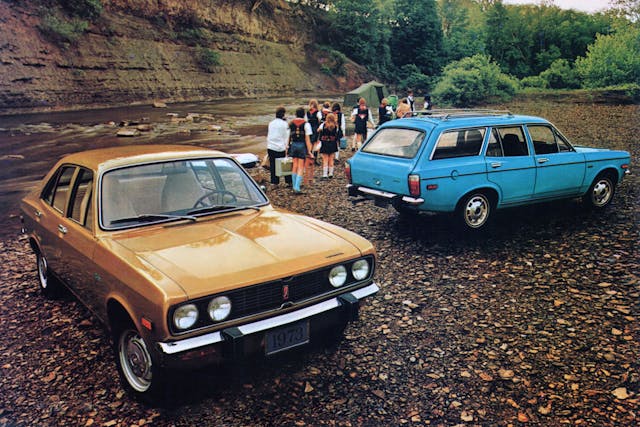
In a curious turn of fortunes, Chrysler was successful with Mitsubishi imports in the 1970s. It sold more than 300,000 Dodge Colts, Challengers (!), Plymouth Champs, Arrows, and Sapporos while developing its own Chrysler Le Baron, Plymouth Reliant, and Dodge Aries K-cars. Few 1970s captive imports survive and 1980s K-cars are scarce, though no one cares.
1991 Lotus Elan M100
Sturdy if bland, the Lotus Elan M100 was reputedly penned by a Japanese team competing for the design of the Mazda Miata. Unfortunately, the team lost the bid to Japanese expat Tom Matano, who spent years working for GM before moving to Mazda’s North American arm.
The Elan offered a 165-hp, 1588-cc, turbocharged DOHC fuel-injected Isuzu four-cylinder engine, which drove the front wheels via a five-speed manual gearbox. The car weighed 2249 pounds and was capable of 135 mph. While it was quick and handled well, front-wheel drive was anathema to Lotus fans; in 1991, only 528 were sold in the U.S., at an uncompetitive MSRP of $33,900. Worldwide production totaled only 3855.
1975–76 Chevrolet Cosworth Vega
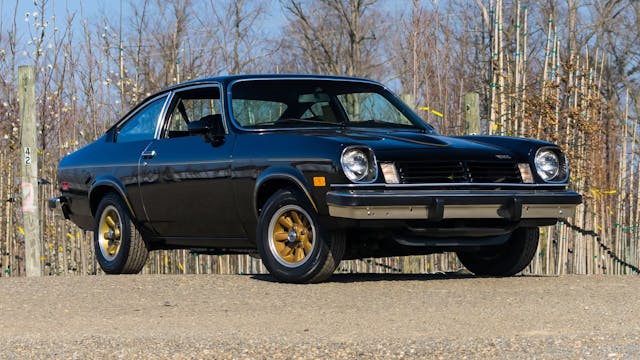
When the Chevrolet Vega was launched in 1971, John Z. DeLorean demanded a twin-cam version aimed at the BMW 2002 and the Alfa Romeo GTA, both of which competed in SCCA and in various European circuits. Keith Duckworth of Cosworth Engineering designed a DOHC engine, 1000 of which were required for homologation. Cosworth’s engine developed 290 hp at 9000 rpm, but the high-silicon alloy blocks kept breaking, and Duckworth quit.
Cosworth’s Weber DCOE carburetors could not be smogged, so the four-cylinder was fitted with Bendix fuel injection and its crankcase reinforced for 1974. But emissions demanded 8.5:1 compression instead of the planned 12:1 ratio. Horsepower plunged to a miserable 110 hp. Then the motor failed EPA testing and the project was delayed until 1975.
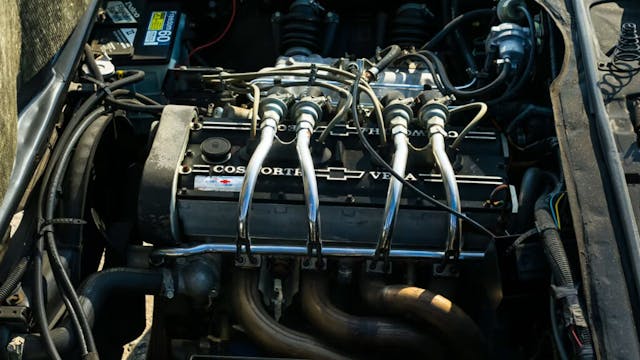
All 1975 Cosworth Vegas were black with gold trim, but cost $5916—double the cost of a standard Vega. Each CosVeg had a four-speed gearbox, unique alloy wheels, full instruments in a gold-tinted dashboard made of turned aluminum, and a numbered dash plaque. 1976 Cosworths came in seven other colors: Antique White, Dark Blue Metallic, Firethorn Metallic, Mahogany Metallic, Dark Green Metallic, Buckskin, Medium Orange, and Medium Saddle Metallic. A five-speed manual was optional.
The muscular price tag and minimal performance meant that only 2061 Cosworths were built in 1975 and 1447 in 1976. Of 1492 leftover engines, a few were used for warranty, 500 disassembled for parts, and the rest scrapped for a tax write-off. Ironically, present-day engine technology can deliver on Cosworth’s original promise.
1970–73 Opel GT
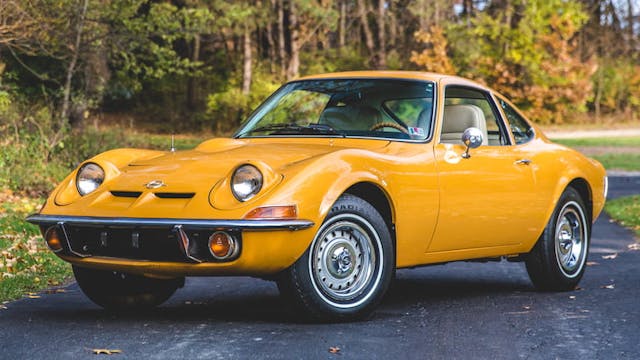
When the Opel GT concept was shown at the 1965 Frankfurt and Paris Motor Shows, it was hailed in Europe as a mini Corvette and reputedly delayed until the strikingly similar C3 Corvette was ready. The GT’s running gear came from the lowly Kadett, but the elegant bodies were built by Brissonneau and Lotz in Paris and shipped to Germany for assembly. Most had a 90-hp, 1897-cc, “high-cam” (almost-OHC) engine. In all, 103,373 GTs were built. About 70,000 were sold in the U.S. by puzzled Buick dealers grateful for an automatic option.
The GT’s layout was intricate. Front suspension was by transverse-leaf with a live rear axle located by coil springs, trailing arms, and Panhard rod. Brakes were disc/drum and steering rack-and-pinion. Hidden headlights were manual and flipped over sideways. There were four round taillights but no opening trunk, for structural rigidity. Road & Track reported 0-to-60 mph in 10.8 seconds, but wind-tunnel research and ram-air induction enabled a top speed of 115 mph.
Bash-bumper laws of 1974 doomed the GT, which suffered chronic rust issues. The 1.9-liter engine had a tiny three-quart sump, so oil levels had to be checked regularly. Those flip-over headlights demanded flexible wiring, but engine heat hardened the harnesses’ plastic insulation, which cracked and led to fires. With so many built by Opel, spares do exist; even better, wrecking yards and hoarders rarely crush these cars.
Volvo P1800 and Jensen

Volvo’s first sports car was the disastrous P1900 roadster in 1955. A fiberglass blob with a pig snout, one tester listed 29 “must fix” problems. Volvo’s CEO Gunnar Engellau took the P1900 on a 447-mile trip and canceled it on his return. Only 68 examples had been sold.
The 1961 P1800 sports coupe was much better. Derived from Virgil Exner Jr.’s Chrysler concepts built by Ghia in the 1950s, the design resembled Ghia’s Thomas Special and Volkswagen’s Karmann Ghia coupe: It wore fins, a curved side spear, and “cow horn” front bumpers. A kitschy interior featured chrome and stylized gauges.
With its factories already running at capacity, Volvo contracted with UK-based Jensen to build the first 6000 examples of the P1800. However, chronic rust issues in the unibodies of the Jensen-built cars forced Volvo to return production to Sweden in 1964. Now called the 1800S, the car’s grille was simplified and its bumper straightened. The curved front bumpers and side spear vanished the next year.
The 1800 was saved from obscurity by actor Roger Moore, who drove one in the seven-year British TV series The Saint. The network wanted a Jaguar E-Type, but Sir William Lyons refused. Volvo’s 1800 proved mechanically bulletproof, with a 1.8-liter B18, four-cylinder, OHV engine, front disc and rear drum brakes, independent front suspension, and vault-like unit construction. Production lasted until 1973. Retired teacher Irv Gordon drove his 1966 model 3,250,257 miles.
Saab 9-2X, 9-7X, 9-6
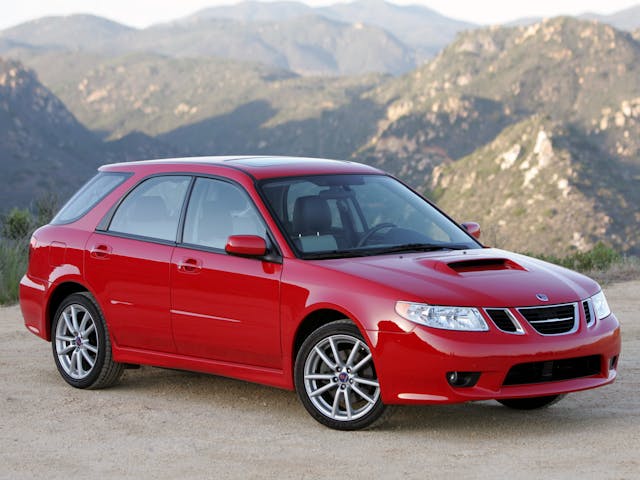
Considering Saab was such a well-defined brand, it’s amazing how many bizarre, rebadged vehicles have carried the name since the egg-shaped 92 was launched in 1950. Never mind the Triumph engine in the 1967 Saab 99; the Saab 600 of 1978 was really a Lancia Delta, while the 9000 of 1985 shared mechanicals with Alfa Romeo 164, Fiat Croma, and Lancia Thema. GM bought 50 percent of Saab in 1989 for $600 million and that resulted in the Opel-based 900 of 1994. Both the 900 and 9000 were renamed in 1997 as the 9-3 and 9-5.
When GM bought the remaining 50 percent of Saab in 2000 for $125 million, it cast around for other ways to monetize the brand. Since GM owned 20 percent of Subaru (Fuji Heavy Industries), an obvious choice was the all-wheel drive, turbocharged WRX Impreza wagon. The five-door Subie was face-lifted forward of the windshield, weighed down with luxury options, improved in numerous mechanical aspects, and saddled with a price tag $3000 higher than the Subaru’s. Launched in 2004, the 9-2X’s best year was 2005, when 5940 were sold. That figure faded to three in 2008. The total count: 9284.
The Saab 9-7X was an expensive Saab variation of the Chevrolet Trailblazer, designed to replace the Oldsmobile Bravada. It debuted in 2005 and managed to catch a bit of the SUV wave, selling 85,994 units before succumbing in the 2008 crash, with 1209 leftovers sold in 2009. Mercifully, perhaps, plans to sell a Saab-badged variation of Subaru’s unpopular Tribeca SUV (badged as the 9-6) were shelved when GM sold its share in Fuji Heavy Industries in 2005. The 9-6 plan was never officially revealed until a prototype was added to the Saab museum in Trollhattan in 2011.
***
Check out the Hagerty Media homepage so you don’t miss a single story, or better yet, bookmark it. To get our best stories delivered right to your inbox, subscribe to our newsletters.
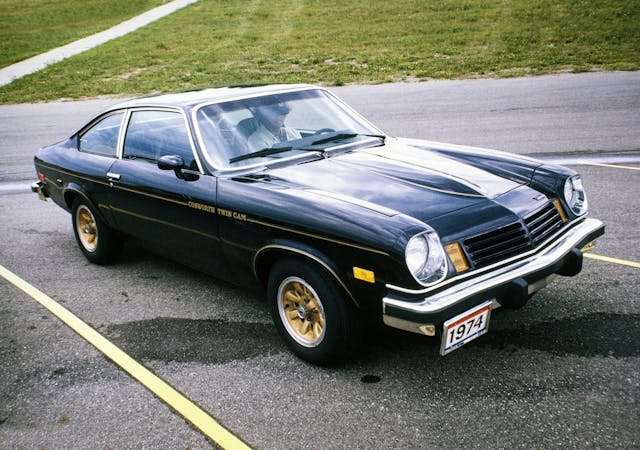















The Saab 9-5 was NOT a renamed 9000. The 9000 shared the platform, as stated above, with the Alfa-Romeo 164, the Fiat Croma, and the Lancia Thema. However, the 9-5 was based upon the Opel Vectra.
I always thought the Opel and the Lotus were very nice looking cars…looks were just not quite enough to ever own one. Opposite problem today…some quick, reliable cars that I think are just too ugly to own.
The Vega is definitely no surprise – I have hated the Vega since the day it was born…it’s one of those cars that I can’t even understand how it could make it to production.
From the first time I saw a 2CV, I liked it. I also liked the VW Beetle and to me they are similar cars. I am also a big fan of the Open GT and the Volvo 1800. I actually had a 74 Vega in 1980 through 1982. It was a plain 4 cylinder station wagon Vega, manual transmission, with fake wood grain. It always performed well for me with no problems. And I might add that I was young and a little hard on cars.
Funny. I owned 2 of these featured boondoggles- the CosVega and the OPEL GT. Loved them both until the inherent problems began manifesting. Wha a shame. They will both hold a soft place in my heart.
i have a 1972 VEGA totally rebuilt head for sale……please email or call 519-734-1654 thanks
I worked for GM in the late 60’s early 70’s–Checking floorplans at GM dealerships, etc. I was shocked at the high price that the Opel GT carried – around $3500.+- if I remember correctly. For another $1,500. to $2,000. you could buy a real Corvette.
Bought a 71 Vega Kamback Wagon for daughter to drive to school (93k miles) and it ran well using a small amount of oil between changes. Told said child to check oil/water regularly as the engine history was well known. School was close so figured little harm could occur if she was careful. Ha, first melt Dow was averted an upper radiator hose blew right into snorkel killing engine…..replaced head and warning again…..second meltdown was fatal…….
My first car bought in 1978 was a used 1974 Vega. 3 spd, no A/C. Biggest piece of junk I’ve ever owned. I used to pull into the service station to fill ‘er up (with oil) and check the gas. I managed to make it last until 1982 by which time if you parked on a hill it would roll even while in gear if you didn’t engage the parking brake. Blew a head gasket and I sold it for $95 and counted myself lucky that I didn’t have to pay a tow truck driver to haul it off. I liked the Cosworth but no way was it worth that money for that piddly amount of HP.
A similar story – my cousin’s Vega overheated somewhere between Dumas and Texline on a snowy night in January while we were on our way to ski. After some hitch hiking and a long night in a very cheap motel we got it towed back to Dumas where the verdict was that the engine was doomed. We left it to the mechanic as compensation for giving us a ride to Amarillo so we could take a Greyhound back to Dallas.
The Tiger engine issue mainly was because Chrysler motors had bulkier dimensions than Ford 260/289s and could not fit easy enough into the Tiger body. The Sunbeam Arrow and Cricket were poor cars, victims of the poor quality after Chrysler took over Rootes . The Minx was collateral damage.The 66/67 Minx did not have a pathetic transmission, but a good Borg Warner 35, also used in Volvos.It was 1725cc and could have done with a little more power in the automatic models.The std models were ok.But it was a reliable basic car. What gave the Minx a bad name was the “pathetic transmission” in the 1960/61/62/63/64 models, those that used Smith’s Easidrive system, a std type transmission automatically operated by electrical governors, switches etc.If memory serves Renault also briefly put out some models with Easidrive. An abortion, trouble prone ,particularly in colder climes, it would drive itself while positioned in neutral.It killed Rootes. It didn’t help that Easidrive followed on the heels of another abortion called Manumatic by AP company. It was a std type transmission which had a clutch( but no pedal ) and automatically shifted gears by pressing in the knob on the end of the gear lever on the steering column. Manumatic was used in the Series II Minx in ’58/59 . With regard to the Pinto, I had a ’72 Pinto Sedan, 1600 cc Cortina motor , put 140,000 miles on it before I had to replace the original clutch. It was a good reliable car, used every day until I bought a new 1987 Mustang 2300cc (another very good car). The Pinto was rear ended, before the stories of gas tanks exploding because of rear enders came to light..My wife was driving the car at the time, accompanied by our pet dog, and the car was knocked clear across an intersection by the impact. The tank split but fortunately no explosion. Both survived ok .When it was repaired, a Ford modification installed some kind of shield between the tank and the exhaust .
The Opel GT’s rust problems were no accident; the same company that built those bodies for GM also built Caravelle bodies for Renault. Both cars rusted in the same places.
Vegas were even worse for rust–at least here in Salt Country. A friend’s Vega hatchback suffered the hatch glass shattering while crossing some uneven railroad tracks. The body flexed so much it exceeded the tensile strength of the hatch’s tempered glass. Another friend came out to his Vega after work to find the windshield had fallen inward and broken over the steering wheel. The flange that held the glued windshield in place had rusted to the point where it wouldn’t support the glass. Fortunately it happened while the car was parked.
But many if not most cars of that era simply weren’t designed and/or built to withstand rust. Some were just more egregious than others…
No edit, try again: search https://car-images.bauersecure.com/wp-images/2296/1040×0/lemons2017_07.jpg?scale=down
The whole “Exploding Pinto” was big news back in the day. The media made it sound like any collision would surely result in a great fireball.
I was reading one of the Houston newspapers a few years later and there was about a 1 sq inch story buried deep in the middle of the paper that stated that after NTSB(?) testing that the Pinto was less likely to catch fire than the Japanese imports of the same era. But we can’t be going off and soiling the Japanese quality myth now could we? That was probably the only time that story was run.
I’ll never forget my Plymouth Cricket though I only had it a couple of years before it was totaled by a guy ignoring a stop light. Incapable of speeds in excess of 50 mph uphill against the wind, with a following wind and going downhill it could reach 65, at which speed the roof inverted with a loud whump. Rain inevitably shorted the distributor, which was mounted on the wheel well so the tires blew any water on the road right against it. And though no real harm was done I did have a fire when one of the plastic fuel lines melted. I had a Pinto and though the Cricket was a far worse car, its price, used, was perfect for an impoverished college student.
Gotta love that Saab version of the Subaru fishbowl.
I have a 1966 Chrysler, Rootes Division, sales brochure advertising the Sunbeam Alpine and Tiger. On the inside back cover is this statement: “Here’s how the Sunbeam Tiger V-8 2-year/24,000-mile engine and drive train warranty protects you. . . ” Chrysler did not warranty Tigers for 5 years/50,000 miles, but rather copied Ford’s then existing warranty. No mention is made of warranty provisions for the rest of the car.
Also the 1948-52 Austin A90 Atlantic, Leonard Lord’s idea for a car that would appeal to North American buyers. (Its powertrain was later used, however, for the Austin-Healey 100.)